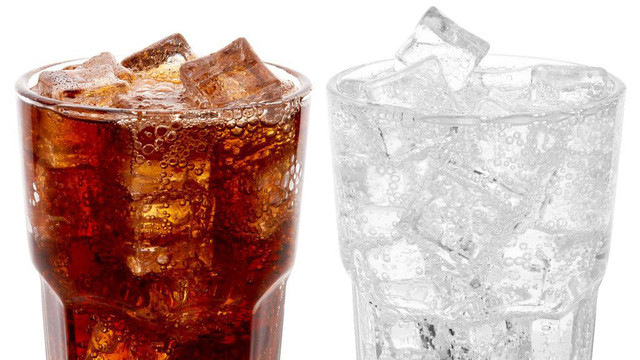Why use CO2 in carbonated soft drinks?
When you open the lid of a soft drink bottle or a beer can, you will see bubbles coming out, which is CO 2 . But why use CO2 but not another gas?
CO2 is the product produced in the combustion or respiration of people and animals. Under normal conditions, CO 2 is an odorless, colorless gas with a slightly sour taste.
Create sour taste

What is the role of CO 2 in carbonated soft drinks?- (Photo: Getty Images).
CO2 when dissolved in water forms a weak solution of carbonic acid.
It is carbonic acid combined with flavoring in carbonated soft drinks that creates a sour taste characteristic of the product.
When taken, carbonic acid stimulates the palate, making us feel the sweet and sour taste of soft drinks. No CO 2 , extremely bland drink.
In addition, when the carbon dioxide foams on the surface and a special "spray", it makes the product more attractive, awakening both the sight and hearing of the user.
Safe, much soluble in water

CO2 is a common gas, soluble in water and safe - (Photo: Getty Images).
Page Science ABC shows good solubility in water as the most important reason for using CO2 in soft drinks. Accordingly, 1.5 liters of CO2 can dissolve in 1 liter of water under normal pressure gas conditions.
Another reason is safety. In general, CO 2 is less toxic. Whether hydrogen sulfide (H 2 S), ammonia (NH 3 ) or sulfur dioxide (SO 2 ) is highly soluble in water compared to CO 2 but cannot be used because of the potential for high toxicity.
When dissolved in water, CO 2 produces very weak carbonic acid (H 2 CO 3 ). This differs from other gases when dissolved with water to produce very toxic strong acids.
Methane can be used to replace CO 2 in carbonated drinks, but methane is flammable. In addition, the environmental impact of using a gas at an industrial level can also be included.
Product preservation

Today, people often produce dry ice from CO2 used in food preservation - (Photo: Alamy).
In the air, oxygen accounts for 20%, much more than CO2, but why not use O 2 in carbonated drinks?
O2 is the cause of spoiled food and drinks. In food, there are many unstable substances unsaturated fatty acids, aromatics, pigments, vitamins, which are prone to oxidation when exposed to oxygen or air. Food and drink for a long time have rancid, stale, scented or discolored phenomena.
Therefore, it is impossible to use such "destructive" gases in soft drinks.
The cost of CO 2 is also very cheap, can be used for industrial production. Besides, taking advantage of CO 2 emissions to create products of economic value and avoiding centralized pollution is also a notable issue.
In short, there are a lot of gases that are better than CO 2 at some point but synthesizing all the factors: dissolving, safe, sustainable, popular, cheap, the best CO2.
It should be noted that when using soft drinks with high CO 2 concentrations, it can lead to the phenomenon of spinal calcification, painful teaching, and ulcerative colitis.
CO 2 is also heavier than air, so if you use drinking water with a high concentration of CO 2 , it will make it difficult to breathe and accumulate long, which can cause heart failure.
Why open a bottle of CO 2 water?

CO2 is compressed with high pressure in soft drinks cans - (Photo: ykonline).
According to Live Science, freshwater plants use high pressure to press CO 2 into water with a mass / area ratio of about 84.36 kg / cm2. The water is then loaded into the bottle and sealed, keeping the pressure high.
When opening the bottle, the pressure outside is low, so millions of CO2 molecules immediately fly into the air, causing the bubbles to escape like boiling water.
When we drink soft drinks, the stomach and intestines do not absorb CO2. The high temperature environment in the stomach makes CO 2 quickly follow the mouth to escape, taking away some heat in the body to make the drink feel cool and pleasant.
CO 2 has a mild stimulating effect on the stomach wall, enhances gastric secretion, helps less digestion.
- 180,000 people die from carbonated drinks every year
- Carbonated soft drinks harm the heart and eyes
- Americans are in danger because of carbonated soft drinks
- Be careful with carbonated drinks
- The implicit harm of carbonated beverages
- Why is carbonated water poured into the cup when it is poured?
- Remove stains with ... carbonated soft drinks
- Carbonated water causes aggression in children
- 10 super strange Pepsi flavors you can only find in Japan
- Fresh water and 12 roads soon take you to see death
- Reduce fat with fresh water
- The teeth change color black when soaked in soft drinks for two weeks
 'Fine laughs' - Scary and painful torture in ancient times
'Fine laughs' - Scary and painful torture in ancient times The sequence of numbers 142857 of the Egyptian pyramids is known as the strangest number in the world - Why?
The sequence of numbers 142857 of the Egyptian pyramids is known as the strangest number in the world - Why? History of the iron
History of the iron What is alum?
What is alum?